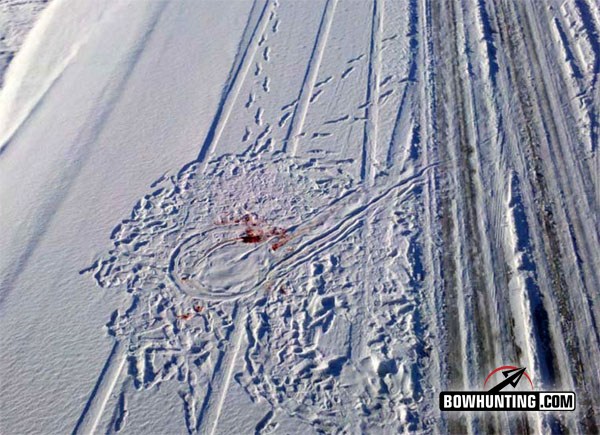LAST UPDATED: May 8th, 2015
When Al Rinka and his highway construction coworkers spotted a huge white-tailed buck crossing a field south of Marshfield, Wis., during their lunch break Dec. 8, they didn’t realize they were watching a dead buck walking.

Lane Wetterau of Stevens Point, Wis.; Aaron Seit, Wisconsin Rapids; Al Rinka, Osseo; and Dave Katzner, Arpin; pose with a giant white-tailed buck that leaped to its death from a bridge over an unopened section of U.S. Highway 10 south of Marshfield.
About an hour later, the buck walked up the embankment to the Washington Avenue bridge 1.5 miles away, leaped off and died on a concrete slab 34 feet below. The buck apparently panicked as a car approached, and jumped over the bridge’s parapet without realizing its height from the ground. The momentum from its leap carried the buck about 30 feet from the bridge’s base, where it landed head first.
The concrete below had been poured recently as part of the U.S. Highway 10 reconstruction, and isn’t yet open to traffic. A foreman for the road-grading crew called Rinka to tell him and his coworkers about the freak accident. When they heard the location, the men realized they had built that section of highway, and still referred to it as “our slab.”
This trophy buck leaped off the highway overpass in the background. The bridge’s height is 34 feet.
When Rinka and his friends — Lane Wetterau, Stevens Point; Aaron Seit, Wisconsin Rapids; and Dave Katzner, Arpin — arrived to see the dead buck, they instantly recognized it as the one they had seen during lunch.
“We’re big hunters, and we all hunt anywhere from 15 minutes to an hour from there, but we saw nothing like that buck during gun season,” said Rinka, a civil engineer from Osseo. “We were amazed to see it crossing a field in broad daylight. It was opening day of the (four-day) antlerless hunt, so maybe some hunters pushed it out. We watched about 10 minutes before we lost sight of him. It’s a huge field.”
Rinka said he and his coworkers noticed the buck had a slight limp. They thought maybe a front leg was injured, but found no wounds or breaks when examining it later. The buck apparently landed on its nose, because nothing else on its body appeared broken, and its antlers weren’t damaged.
Rinka said an elderly woman who lives near the bridge was driving the car that spooked the buck. She told them the buck was standing in the middle of the road as she approached. It could have run down the road to get off the bridge, but jumped over the side instead.
Al Rinka of Osseo, Wis., displays the impressive buck that survived Wisconsin’s nine-day firearms season in November, only to die 10 days later in a freak accident.
The woman stopped and looked over the bridge, and saw the buck writhing on the pavement in its death throes. She drove home and told her neighbor, who is a hunter. He notified authorities and received a tag so he could claim the buck.
Rinka and his friends marveled at the buck’s antlers. “As much as all of us hunt, and after all the time we’ve spent in the woods, here we were staring at probably one of the biggest bucks we’ll ever see, and it jumped off a bridge,” he said.
The buck had a 12-point rack with wide beams and thick tines. Rinka said the tallest tines were about 9 inches long, and the spread between the main beams spanned 18 inches. They guessed it would score 150 to 170 inches on the Boone and Crockett Club’s measuring system.
The buck’s flying leap carried it about 10 yards from the base of the bridge.
He said the buck had a smaller body than what they expected. Then again, it’s not unusual for a buck’s body to look small, even emaciated, in the weeks following “the rut,” the whitetail’s mating season. Rutting bucks can lose about 25 percent of their body weight while seeking and chasing does. This buck weighed 180 pounds when it died, so it might have weighed around 240 pounds when alive.
In the days that followed, some people jokingly referred to the deer as “The Suicide Buck,” but Rinka said no one there truly believed the buck intended to kill itself.
“What it was doing on that bridge, who knows?” he said. “There’s much easier ways to cross that area than by walking up an overpass. It’s a confined area, and deer seldom walk on bridges anyway. It was out of its element, and probably just panicked when the car approached.”
Although Rinka doesn’t buy the suicide theory, humans have long debated the possibility of animal suicide. About two years ago, for example, “Time” magazine reminded readers that Aristotle (384-322 BC) told of a stallion that leaped into an abyss after realizing it was duped into mating with its mother.
In more recent times, the Overtoun bridge in Milton, Scotland, has gained notoriety as the “Dog Suicide Bridge” because dogs have jumped from it about once a month since the 1960s, causing about 600 to die. Some dogs have even survived, only to run back up and jump again. No one knows what’s causing them to leap.
Rinka is content to consider the buck’s leap a fluke of nature.
“We were dumbfounded when we realized it was the same buck we had seen during lunch,” he said. “When it walked out of sight, we thought we’d never see it again. It was unreal.”

 By
By 






